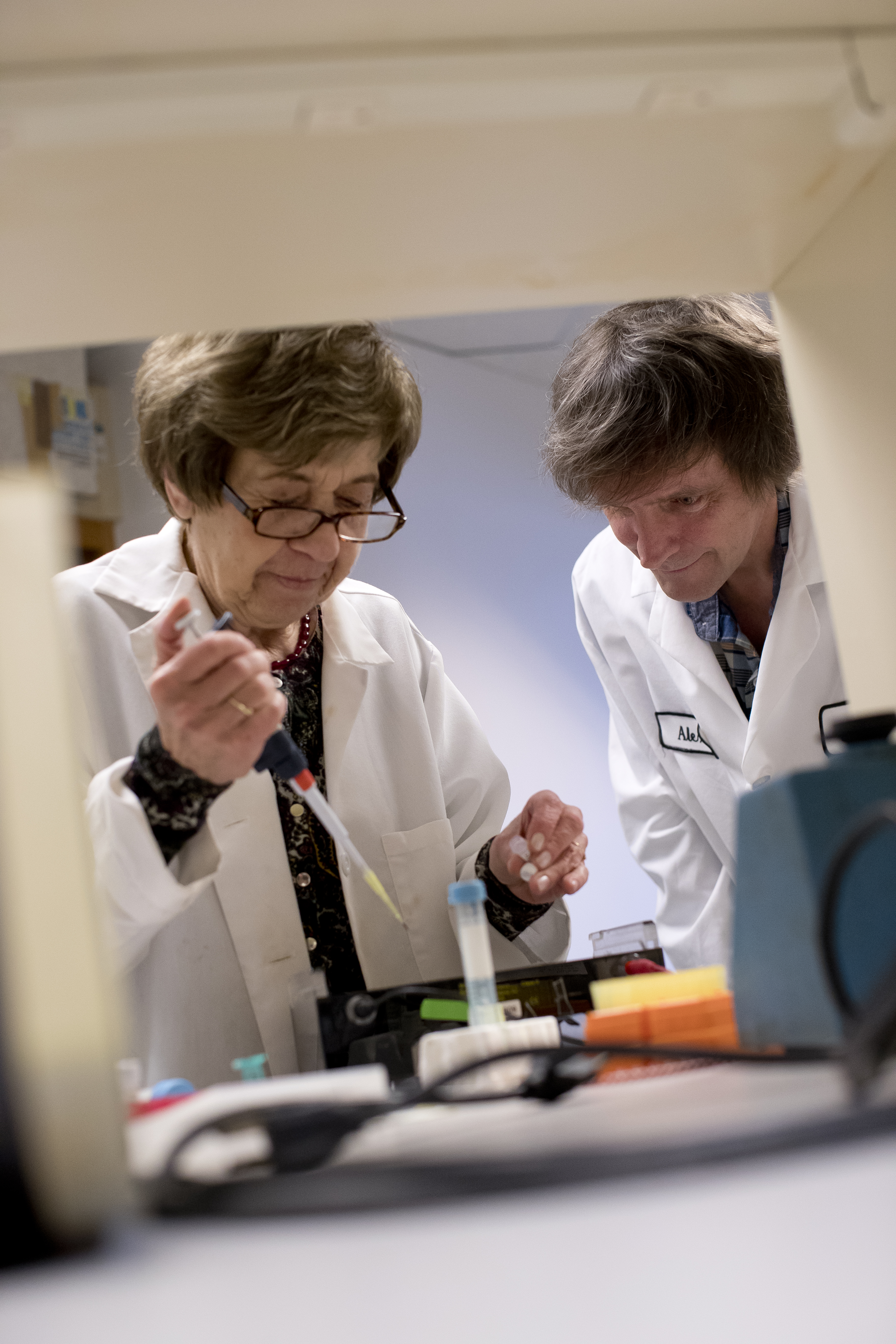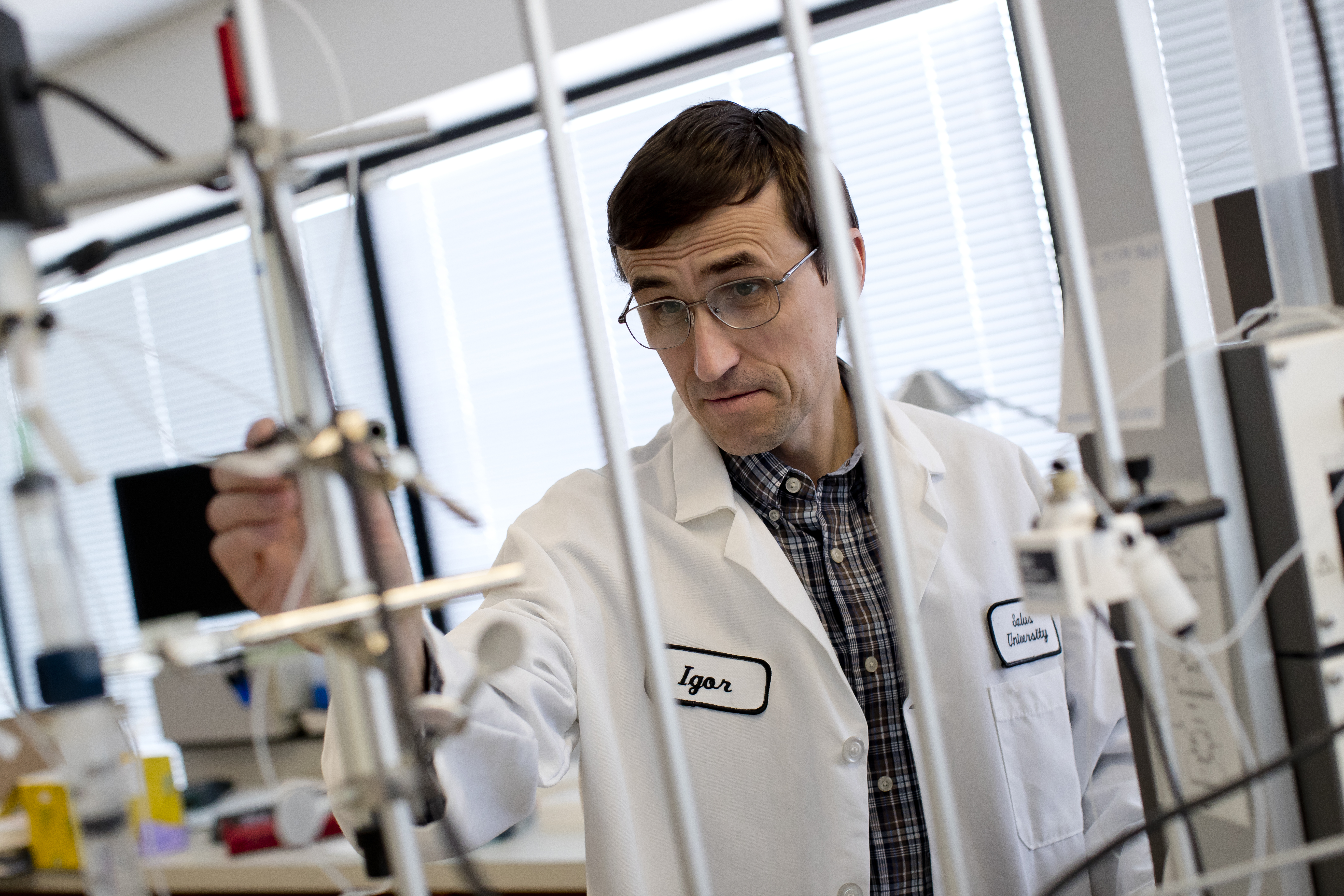The Pennsylvania College of Optometry (PCO) originally developed an emphasis on biomedical sciences, visual sciences and clinical trials which resulted in the start of the Research Program.
Before becoming Salus University, the biomedical program was led by Alexander Dizhoor, PhD, Hafter Family Chair in Pharmacology.In 2002, Dr. Dizhoor moved his laboratory from Wayne State University, in Detroit, Mich., to PCO, in order to conduct studies in molecular biology, pharmacology and congenital diseases of photoreceptors.
Dr. Dizhoor and his team, including Igor Peshenko, PhD, assistant professor; and Elena Olshevskaya, PhD, instructor, have been funded by the National Eye Institute, located in Bethesda, Md., for over 20 years and have been working on signal transduction in retinal rods and cones and its link to congenital blinding disorders. The team’s work has been featured in many academic journals and professional publications as they were the first to restore light sensitivity in retinas lacking photoreceptors.
 In mid-2006, Rameshwar Sharma, PhD and Teresa Duda, PhD and both PCO distinguished professors of Biochemistry and Molecular Biology, established the Unit of Regulatory and Molecular Biology with the aim of continuing studies on membrane guanylate cyclase signaling mechanism in the sensory neurons and cardiovascular system and to form a solid foundation of basic research at PCO, before PCO became Salus University.
In mid-2006, Rameshwar Sharma, PhD and Teresa Duda, PhD and both PCO distinguished professors of Biochemistry and Molecular Biology, established the Unit of Regulatory and Molecular Biology with the aim of continuing studies on membrane guanylate cyclase signaling mechanism in the sensory neurons and cardiovascular system and to form a solid foundation of basic research at PCO, before PCO became Salus University.
Today, the Research Program plays an essential role in establishing the credibility of the University. Research and scholarly activity are intrinsic components of academia and help a university establish itself as a credible entity. When a Salus researcher and scholar present research results in journals and conferences, it attracts national and/or international recognition, and benefits the University, our faculty, staff, and students.
More importantly, research leads to discoveries about diagnoses and treatments that directly improve the care of patients seeking healthcare in the University’s clinical programs, as well as nationally and internationally.
Having a strong research program also enables the University to attract and maintain a strong faculty and establishes a stimulating environment in which scholars and teachers are searching for truth, and creating a spirit of discovery - a critical component of any institution of learning.
Today, researchers from each of the University’s four Colleges are actively involved. The list below demonstrates the large number of ongoing research projects at the University and the wide participation from all Colleges and programs.
In addition, to this laboratory-based research, there has been and continues to be a large number of projects involving human subjects. Elise Ciner, OD, PCO professor has been one of the most active of the University’s researchers over the past two decades, conducting ground-breaking research related to vision screening in pre-school children and other studies investigating the effect of hyperopia on early childhood development.

Mitchell Scheiman, OD, PhD, dean of Research and director of Graduate Programs in Biomedicine was funded by the National Eye Institute to study the effectiveness of treatments to slow the progression of myopia - nearsightedness. Erin Jenewein, OD, PCO assistant professor, is currently the principal investigator for an industry funded study of the use of atropine eye drops to slow the progression of myopia. Richard Bennett, OD, director of the Glaucoma Service of Excellence and lecturer in Retinal Disease and Glaucoma has been the principal investigator for The Ocular Hypertensive Treatment Study (OHTS) funded by the National Eye Institute (NEI) of the National Institutes of Health (NIH) for over 20 years. This study investigated the benefits of reducing elevated intraocular pressure in the development of open-angle glaucoma which is one of the leading causes of blindness in the United States and the leading cause of blindness in African Americans.
Dr. Scheiman was also the national study chair for the Convergence Insufficiency Treatment Trial and his investigator group produced the first results from randomized clinical trials about the effectiveness of vision therapy for convergence insufficiency. In addition, there have been many studies completed and ongoing studies studying the most effective ways to treat amblyopia in children. Jingyun Wang, PhD, associate professor, has an active research laboratory investigating the treatment of amblyopia.


 In mid-2006, Rameshwar Sharma, PhD and Teresa Duda, PhD and both PCO distinguished professors of Biochemistry and Molecular Biology, established the Unit of Regulatory and Molecular Biology with the aim of continuing studies on membrane guanylate cyclase signaling mechanism in the sensory neurons and cardiovascular system and to form a solid foundation of basic research at PCO, before PCO became Salus University.
In mid-2006, Rameshwar Sharma, PhD and Teresa Duda, PhD and both PCO distinguished professors of Biochemistry and Molecular Biology, established the Unit of Regulatory and Molecular Biology with the aim of continuing studies on membrane guanylate cyclase signaling mechanism in the sensory neurons and cardiovascular system and to form a solid foundation of basic research at PCO, before PCO became Salus University.




